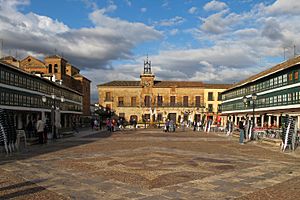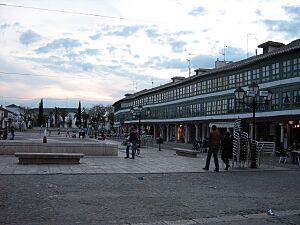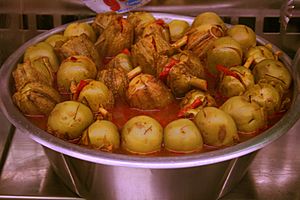Almagro, Ciudad Real facts for kids
Quick facts for kids
Almagro
|
|||||||||||||||
|---|---|---|---|---|---|---|---|---|---|---|---|---|---|---|---|

Plaza Mayor
|
|||||||||||||||
|
|||||||||||||||
| Country | Spain | ||||||||||||||
| Autonomous community | Castile-La Mancha | ||||||||||||||
| Province | Ciudad Real | ||||||||||||||
| Comarca | Campo de Calatrava | ||||||||||||||
| Area | |||||||||||||||
| • Total | 249.73 km2 (96.42 sq mi) | ||||||||||||||
| Elevation | 646 m (2,119 ft) | ||||||||||||||
| Population
(2018)
|
|||||||||||||||
| • Total | 8,922 | ||||||||||||||
| • Density | 35.7266/km2 (92.531/sq mi) | ||||||||||||||
| Demonym(s) | Almagreño/ña | ||||||||||||||
| Time zone | UTC+1 (CET) | ||||||||||||||
| • Summer (DST) | UTC+2 (CEST) | ||||||||||||||
| Postal code |
13270
|
||||||||||||||
|
|||||||||||||||
Almagro is a charming town in the Ciudad Real province of Castile-La Mancha, Spain. It's a popular place for tourists and is known as a Conjunto histórico, which means it's a special area protected for its history and beauty.
The town is located near small mountains and has some shallow creeks. It's also in a volcanic area, which is quite rare in the Iberian Peninsula. This makes Almagro a unique place to visit. Every year since 1978, Almagro hosts an International Festival of Classical Theater.
Contents
History of Almagro
Early Settlements and Roman Times
We don't know exactly when people first lived in Almagro. Some clues suggest there might have been a settlement during the Bronze Age. This idea comes from old findings in the Casas Maestrales and other spots around town.
During the Roman era, people definitely lived here. A scholar named Galiano y Ortega believed he saw parts of a Roman aqueduct. Roman coins and a headstone have also been found. The headstone is now in the Town Hall. The name Almagro comes from the Arabic word 'al-magra', meaning 'red clay'. This name was given by the Moors who settled in Spain.
The Middle Ages
In the 13th century, Almagro became very important. The Order of Calatrava, a powerful knightly order, chose Almagro as their main home. This made the town a center for their government and activities.
A local story says that a leader of the Order, Don Gonzalo Yánez, gave the town its first rules in 1213. Later, King Ferdinand III of Castile approved these rules in 1222. In 1273, King Alfonso X of Castile held an important meeting, called the Cortes, in Almagro.
By the 14th century, Almagro had a wall around it. It also had a church, butcher shops, a jail, a town hall, and a castle. The castle was part of the buildings owned by the Order of Calatrava.
In 1374, King Henry II of Castile allowed Almagro to hold two fairs. This helped the town's trade and economy grow.
In 1487, the role of the Master of the Order became part of the Crown of Castile. This meant the king now controlled the Order. However, this change did not harm Almagro. The Royal Governor moved into the palaces where the Masters of the Order used to live.
In 1493, Cardinal Cisneros ordered the building of a Franciscan monastery. This monastery, called Santa María de los Llanos, is no longer standing today.
Later, because King Charles I of Spain needed money, German bankers from the Fugger family took over the mines in nearby Almadén and Almagro. They brought German managers to the town. Some of their old manor houses can still be seen today.
Growth in the 16th and 17th Centuries
Almagro grew a lot during the 16th and 17th centuries. The town expanded beyond its old walls, and new neighborhoods were built. Many important buildings were constructed during this time. These included churches, convents, and grand manor houses. The Main Square (Plaza) and the Town Hall were also rebuilt.
Even when Spain faced problems in the late 16th and early 17th centuries, construction in Almagro continued. New religious orders like the Augustinians and Jesuits came to the town. A wealthy nobleman, Juan Francisco Gaona y Portocarrero, also built his palace here.
Almagro became even more important thanks to King Philip V of Spain and the nobleman Juan Francisco Gaona y Portocarrero. He was a key figure in the king's government.
The town was named the capital of the La Mancha region from 1750 to 1761. Although Almagro didn't stay an administrative center forever, its leaders encouraged trade, especially in beautiful appliqué lace and pillow lace.
The 19th Century
During the Peninsular War, Almagro had a group of supporters for Napoleon. The town also faced challenges during the Carlist Wars.
In the 19th century, Almagro built a Plaza de Toros (bullring) in 1845. It was made from stones from an old church tower that had been taken down. A famous bullfighter named Cagancho once had a very bad performance here. This led to a Spanish saying, "quedar como Cagancho en Almagro", which means "to suffer a great public failure."
Modern things like the telegraph (1858), railway (1860), and electricity (1897) came to Almagro during this time. In 1886, the old town walls and gates were taken down.
The 20th Century and Today
In the 1950s, a very old theater called the Corral de Comedias was found and fixed up. The Town Hall and the Main Square were also restored. In 1972, Almagro was officially named a Historical-Artistic Zone. Many old buildings, including churches and palaces, were repaired.
The National Museum of Theatre was built in Almagro. The town became a major center for theater and arts in the region. The International Festival of Classical Theater continues to be held here. Almagro is even being considered as a World Heritage Site because of its rich history and culture.
Economy and Local Delights
Almagro's economy relies on farming. Crops like cereal, grapes (for wine), olives, and cotton are grown here. There's also livestock farming. The town has quarries for basalt stone and mines for manganese and plaster.
A very special traditional craft in Almagro is making appliqué lace and pillow lace. These beautiful laces are made by skilled artisans called encajeras. Other local industries include woodworking and construction.
Almagro is also famous for a unique type of small aubergine (eggplant) called berenjenas de Almagro. These eggplants are seasoned and pickled using a traditional recipe. They are often eaten as a snack, along with other tapas.
As mentioned, the International Festival of Classical Theater has been held here every year since 1978, bringing many visitors to the town.
Famous People from Almagro
- Diego de Almagro, a famous Spanish explorer and conqueror.
- Conde de Valdeparaíso, a nobleman who helped the town grow.
- Juan Frederic Geldre, a writer.
- Fray Antonio de Lorea, another writer.
- Vicente and Francisco Rujero, known as "los Palillos", who were Carlist guerrillas.
- Federico Galiano y Ortega, a historian.
Must-See Places in Almagro
- Plaza Mayor: The main square, famous for its unique design.
- Corral de Comedias: A well-preserved 17th-century theater, one of the only ones of its kind.
- Manor Houses: Many old, grand homes built by important families.
- Palaces:
- Palacio de los Marqueses de Torremejía
- Palacio de los Condes de Valdeparaíso
- Palacio de los Medrano
- Palacio de los Fúcares: This was actually an old warehouse built by the Fugger Family.
Museums to Explore
- National Museum of Theatre: Learn about the history of theater in Spain.
- Museo Etnográfico Campo de Calatrava: Discover the local culture and traditions.
Churches and Convents
- Convento del Santísimo Sacramento
- Iglesia de la Madre de Dios
- Convento de Santa Catalina
- Convento de la Encarnación
- Convento de la Asunción de Calatrava
- Iglesia de San Bartolomé
See also
 In Spanish: Almagro (España) para niños
In Spanish: Almagro (España) para niños






